#Wang Xizhi
Text




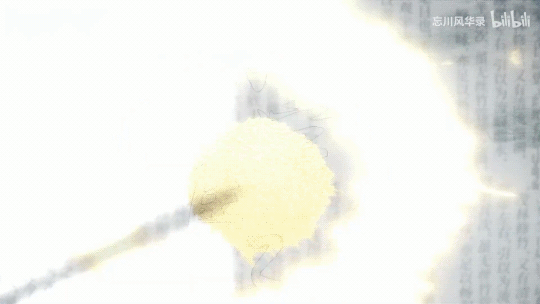

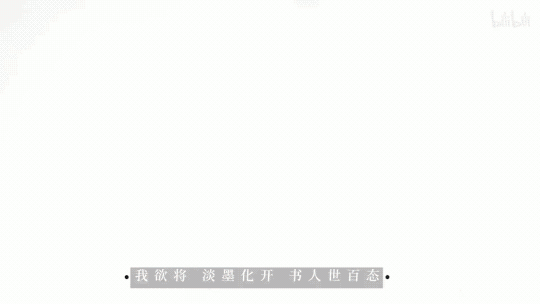


❝I want to turn the past into elegant words
As we are but a drop in the ocean❞
🖌
好字唯之 / 【忘川风华录】
Wangchuan gifset — 4/?
#忘川风华录#Wang chuan feng hua lu#wcfhl#chinese music#gufeng#gifset#gifs#moving gifs#gufeng music#yi shui jue#mine#synth v#synthv#synthesizer v#haiyi#haiyi synthv#vocal synth#好字唯之#hao zi wei zi#wang xizhi#gifing this makes me realize I don't like this mv's visuals as much as I used to
3 notes
·
View notes
Text
"Future readers will look back on today just as we look back at the past. How sad it all is! Therefore, I have recorded my contemporaries and transcribed what they have written. Over distant generations and changing events, what gives rise to melancholy will be the same. Future readers will also feel moved by these writings."
-- Wang Xizhi, Lantingji Xu/Preface to the Collected Poems from the Orchid Pavilion (transl. Richard E. Strassberg)
#quote#poetry#wang xizhi#richard e. strassberg#chinese literature#lantingji xu#orchid pavilion gathering
0 notes
Text
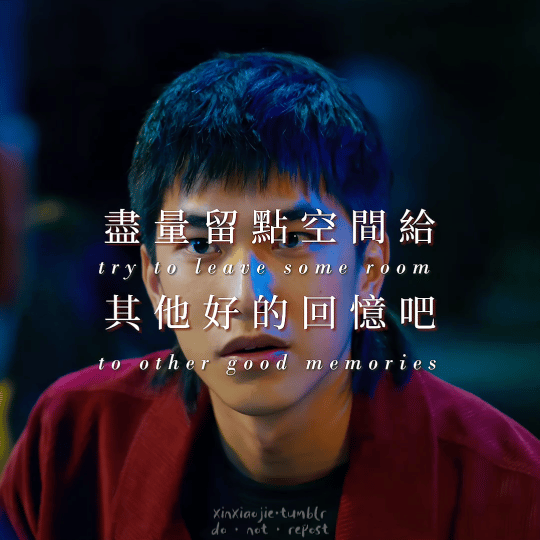
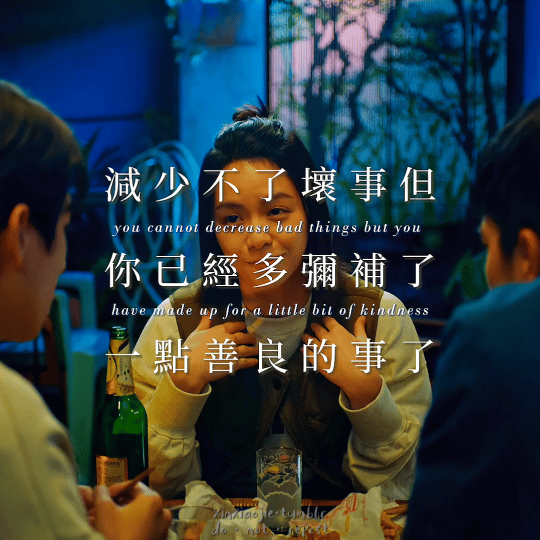

Four Treasures of the Study · 文房四宝
蒲一永 Pu Yi Yong · The Brush
Eight Principles of Yong. Traditionally, it was believed that practicing the eight common strokes in regular script, all of which can be found in the character "Yong," could lead to writing all characters well. According to legend, it was created by Wang Xizhi in the Eastern Jin Dynasty, "Yong" is also the first character in his famous work 蘭亭集序 Lantingji Xu (Preface to the Poems Collected from the Orchid Pavilion).
The surname "Pu" could potentially be a homage to the famous Chinese writer Pu Songling in the Qing Dynasty. In his most popular work 聊齋誌異 Liaozhai Zhiyi (Strange Tales from a Chinese Studio), the focus of the tales are on the emotional entanglements between humans and supernatural beings in the world.
陳楮英 Chen Chu Ying · The Paper
Chu, which refers to the paper mulberry plant, was historically used in ancient China as the raw material for making mulberry paper and Xuan paper. Additionally, "Chu" was used as a term synonymous with paper in ancient times. In EP4, Chuying mentioned that the "chu" in her name means paper.
曹光硯 Cao Guang Yan · The Inkstone
Yan, also known as Yantai, is the name of the inkstone used in calligraphy. The inkstone is used to grind the ink stick into powder, which is then mixed with water on the inkstone to create ink suitable for calligraphy.
執念 The Obsessions · The Ink
The obsessions are one of the ever-changing elements in the show, the elegiac couplets are uniquely written with whole heart and mind for the different obsessions.
#oh no! here comes trouble#oh no here comes trouble#不良執念清除師#不良执念清除师#twdramaedit#asiandramasource#dailyasiandramas#cdramasource#dramasource#twdrama#taiwanese drama#caps#chinese stuff#pu yiyong#Tseng Jing Hua#chen chuying#vivian sung#sung yun hua#Peng Cian You#cao guangyan#i dont even know if this is even interesting to anyone im just splurging thoughts and random meta#this post took 10yrs to make can you believe trying to do the write up was harder than trying to make the gifs#half way through making the gifs i realised i did it in simplified and when i tried to switch to traditional the font didnt work 🥴#i was trying to find a scene where guangyan was in his doctor action but i didnt want to use the cpr scene bc sads#this is he best one i could find where he's wearing a lab coat
323 notes
·
View notes
Text
Today's apocryphal Sun Tzu quote
Wanting to be right and wanting to know the truth are two very different things, indeed.

Qian Xuan - Wang Xizhi Watching Geese, 1295 AD
65 notes
·
View notes
Photo

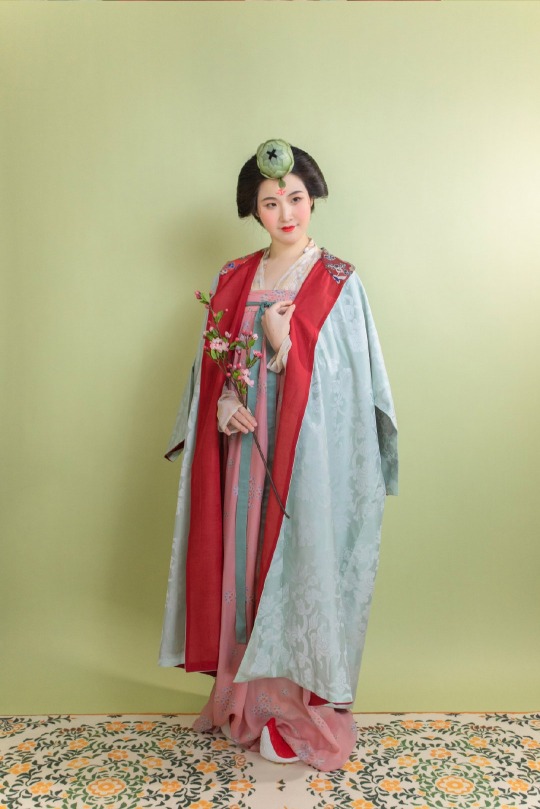

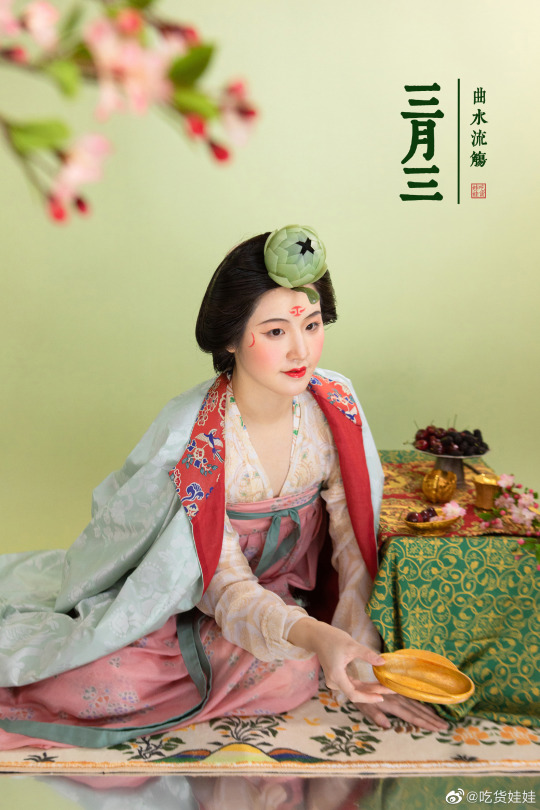


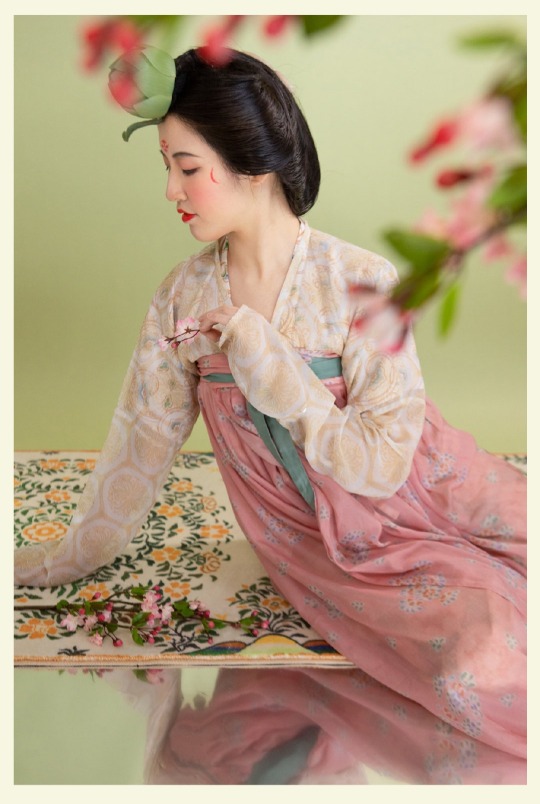


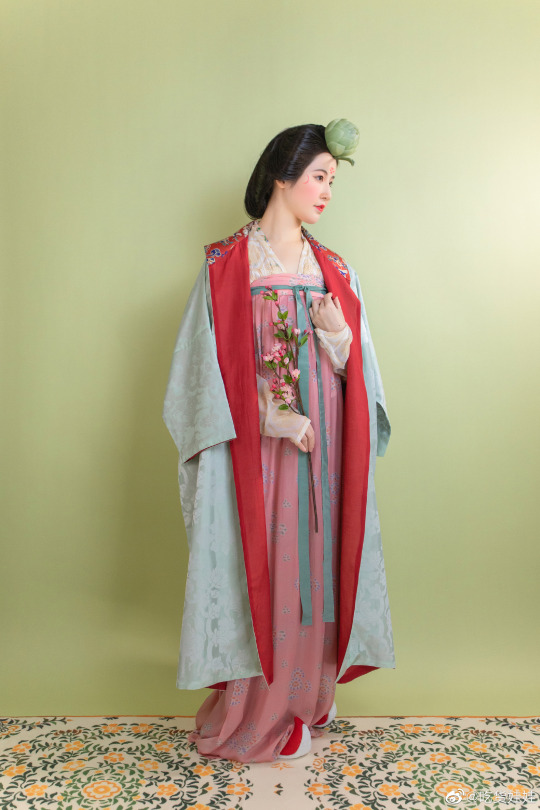
【Historical Artifacts Reference】
Chinese Tang Dynasty Female Figurines in “乌蛮髻/Wū mán Hairstyle”
some will put lotus flowers in the middle of the hair
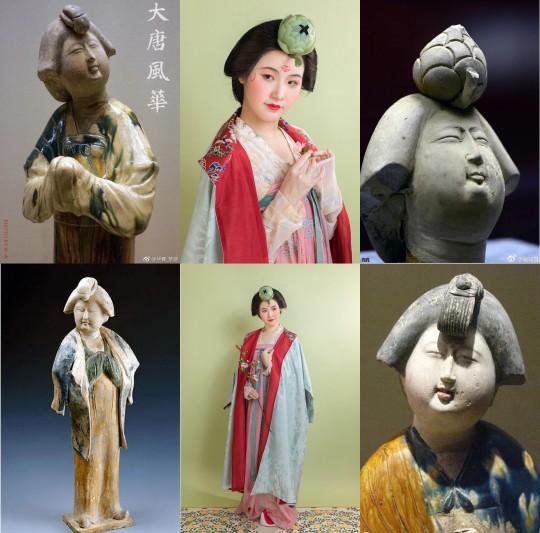

[Hanfu · 漢服]Chinese Tang Dynasty(618-907A.D) Traditional Clothing Hanfu & Hairstyle Based On Tang Dynasty Female Figurines
High Tang Period Women Attire and Hairstyle
————————
📸Recreation Work: @吃货娃娃
🔗Weibo:https://weibo.com/1868003212/MD7GFiYs0
————————
【Shangsi Festival/Double Third Festival/上巳節】
Double Third Festival or Shangsi Festival (traditional Chinese: 上巳節) is a Chinese festival celebrated on the third day of the third month of the Chinese calendar.
It is said that the origin of this festival comes from the Dinner Party at the Qushui River during the Zhou Dynasty (about 1100–221 BC). Others say its origins come from the ceremonial custom of getting rid of evils by bathing in the river. On this day, people would hold a sacrificing ceremony on a riverside to honor their ancestors, and then take a bath in the river with herbs to cleanse their bodies of filth. Following that, young men and women would then go for a spring outing in which many of these scenes were described in Shi Jing (The Book of Songs).
The Shangsi Festival activities have changed over the course of subsequent dynasties. The entertainment feast and praying for descendants along the riverside were added in the Han Dynasty (206 BC-220 AD). It was after the Wei and Jin dynasties (220–420 AD) that the festival developed into the Double-Third (Shangsi) Festival that is fixed on the third day of the third lunar month.
In modern times, to observe this festival, people would go for an outing by the water, have picnics, and pluck orchids. It is also a day for invoking cleansing rituals to prevent disease and get rid of bad luck. The day is also traditionally considered to be a possible birthday of the Yellow Emperor.
The ancient traditions of Shangsi are mostly celebrated by several communities spread out among the provinces today, such as the ancient village of Xinye
The great calligrapher Wang Xizhi mentions this festival in his famous work Preface to the Orchid Pavilion Poems, written in regard to the Orchid Pavilion Gathering during the Six Dynasties era.
The Han ethnic people in some places also have special customs on March 3rd. For example, Hunan and other places have the tradition of "March 3rd, boiled eggs with ground (shepherd's) purse", while Anhui and other places have the tradition of eating Baba( a kind of bread, with meat):

#Chinese Hanfu#Tang Dynasty(618-907A.D)#High Tang Period (650-755 AD)#hanfu#hanfu history#Shangsi Festival#Double Third Festival#上巳節#chinese food#hanfu accessories#hanfu artifacts#Tang Dynasty Female Dancer Figurine#chinese traditional clothing#chinese history#historical clothing#historical hairstyles#chinese coustume#China History#吃货娃娃#齊胸衫裙 qixiong shanqun#pibo 披帛#乌蛮髻(Wū mán Hairstyle)
250 notes
·
View notes
Text

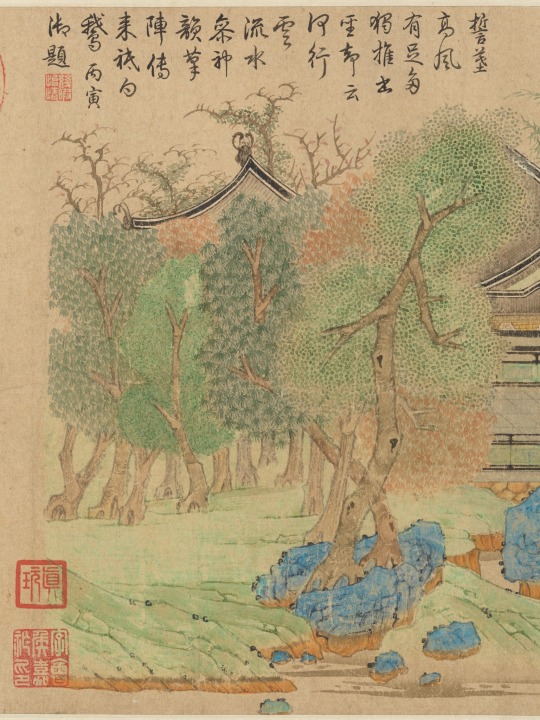

Qian Xuan
Wang Xizhi watching geese (details)
ca. 1295
#Qian Xuan#chinese artist#chinese painter#chinese painting#chinese art#asian art#chinese landscape#landscape aesthetic#aesthetic#beauty#nature#scroll painting#asian aesthetic#chinese aesthetic#art history#aesthetictumblr#tumblraesthetic#tumblrpic#tumblrpictures#tumblr art#tumblrstyle#artists on tumblr
15 notes
·
View notes
Note
Do you have any favorite poet, philosopher, monk, painter, calligrapher or just anyone who fit in these categories?
I like Wang Xizhi, Xie Daoyun and Monk Xuanzang.
5 notes
·
View notes
Text

臨摹 王羲之蘭亭序 唐代馮承素摹本
Preface to the Orchid Pavilion Manuscript e by Wang Xizhi
0 notes
Text
Framed Chinese Calligraphy: Art, History, and the Enduring Use of Brushstroke

Tracing the Rich History and Contemporary Relevance of Framed Chinese Calligraphy
Framed Chinese calligraphy is a tangible witness to an ancient art style that has smoothly crossed decades. These painstakingly created figures continue to serve as compelling windows into China's history, culture, and aesthetic expression as they find their place within elegant frames. In this post, we will travel back in time to investigate the multifarious use and historical significance of framed Chinese calligraphy in the past, as well as its continuous relevance now.
The Ancient Roots of Chinese Calligraphy
Chinese calligraphy may be traced back to the dawn of Chinese civilization. Its history is intertwined with the evolution of the Chinese writing system and ink and brush techniques. Calligraphy was more than just a medium of communication; it was a type of art that encapsulated the spirit of Chinese culture.
Chinese philosophers, poets, and painters developed their calligraphy talents for millennia, attempting to portray the rhythm and vitality of life in their brushstrokes. Famous calligraphers such as Wang Xizhi and Yan Zhenqing's work became legendary, and their works were regarded as masterpieces.
.
The Historical Use of Framed Calligraphy
The practice of framing calligraphy is also ancient. Framed calligraphy was a representation of knowledge, refinement, and cultural sophistication in traditional Chinese residences. These artworks were publicly displayed, frequently in the study or major living areas, and served as a source of inspiration as well as a reminder of timeless knowledge.
Emperors and intellectuals alike understood the value of framed calligraphy in conveying sentiments, goals, and ideals. Imperial decrees and important documents were frequently published in calligraphic style, with intricate designs framing them to indicate their importance.
Framed Calligraphy Today: A Blend of Tradition and Modernity
Framed Chinese calligraphy is still a treasured practice in the modern world. However, its application has expanded beyond scholarly investigations. Framed calligraphy is now in high demand for a variety of reasons.
Artistic Expression: Many contemporary artists continue to explore the beauty of calligraphy while challenging traditional techniques. Framed calligraphy pieces are collected as works of art that strike a profound aesthetic and emotional chord with viewers.
Interior Decor: Framed calligraphy has found a home in contemporary interior design. These works of art bring a touch of cultural refinement to homes and businesses by mixing traditional charm with modern aesthetics.
Personalization & Gifts: Framed calligraphy is a popular option for personalized gifts and special occasions. People hire calligraphers to create personalized pieces that express their feelings, blessings, or goals.
Conclusion: A Timeless Tradition in Modernity
Framed Chinese calligraphy, with its rich history and diverse contemporary applications, exemplifies the continuing power of artistic expression. These brushstrokes, which continue to adorn our homes, offices, and cultural spaces, connect us to the knowledge of the past and inspire us for the future. Framed calligraphy is a live art form that bridges the gap between tradition and contemporary, reminding us of the eternal beauty of ink and brush on paper.
0 notes
Photo

A sculpture titled 'Wang Xizhi (Minimalist Man Modern Abstract statue)' by sculptor Jianyong Guo. In a medium of Bronze.
0 notes
Text
"Upward we gazed to contemplate the immensity of the universe; downward we peered to scrutinize the abundance of living things."
-- Wang Xizhi, Lantingji Xu/Preface to the Collected Poems from the Orchid Pavilion (transl. Richard E. Strassberg)
#quote#poetry#wang xizhi#chinese literature#richard e. strassberg#lantingji xu#orchid pavilion gathering
0 notes
Video
youtube
#springfestival Special: Why do I write Lanting Xu on a palace lantern?. "Looking up, I see the immensity of the #cosmos ; bowing my head, I look at the multitude of the world," reads an excerpt from " #LantingXu " (Preface to Poems Composed at the #OrchidPavilion ), a #Chinesecalligraphy masterpiece by Wang Xizhi (303-361) of the Eastern #JinDynasty (317-420). A #femaleItalianastronaut recited this piece of #Chinesepoetry during her first mission to the #InternationalSpaceStation . The #universe is boundless, with countless stars sparkling within
0 notes
Text
forbidden city

In the Pavilion of the Purification Ceremony, there is a twisting water channel measuring twenty-seven metres long. It was designed in accordance with the verse of "a twisting water channel for floating wine cup and enjoying the drinking festival" in The Preface for the Orchid Pavilion Gathering written by Wang Xizhi of the Jin dynasty(265-420). Modelling himself on Wang Xizhi, the Emperor and his ministers often sat along the channel composing poems and drinking.
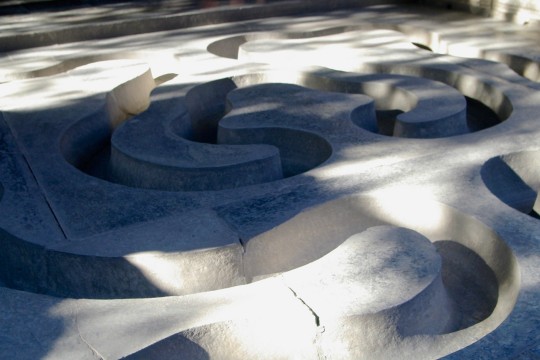
0 notes
Text
Lantinghei Font Download

Download-Font-iOS 1.0.0 on CocoaPods - L.
Shingo'segoe+lantinghei-debold-Font Search-F For Mobile.
Free Lantinghei Tc Fonts.
Download SymbolPicker 1.1.0.
Free Lantinghei SC Extra Light Fonts.
兰亭中粗黑'Segoe Font Download,LanTingHei-DB1-K'Segoe Font.
兰亭黑-简 Font Download,兰亭黑-简 特黑 Font Download,蘭亭黑-簡.
Lantinghei sc font free - lalafep.
Lantinghei SC Extralight Font - What Font Is.
Free Lantinghei SC fonts download - F.
Lantinghei TC Extra Fonts Free Download - OnlineWebFonts.COM.
(chinese mac) Fonts.
Buy, download typography fonts | Adobe Type.
Download-Font-iOS 1.0.0 on CocoaPods - L.
For the following selected fonts, you can go to FontGoods self-service to obtain commercial license. This is a stylish and elegant serif font crafted & designed by Yana Kolesnichenko. Lithium combines rigor, but at the same time it is able to show its sharp character. Floreal is perfect for corporate identities, websites, publications, titles, books, magazines, business cards, logos, product labels, packaging, or any kind of advertising purpose.
Shingo'segoe+lantinghei-debold-Font Search-F For Mobile.
PingF is the Chinese system font in High Sierra. STHeiti L and STHeiti M are the old system fonts. Lantinghei font download. Hey guys, im a noob in all that shit but i have bought a Ru Key of Cod AW. The game is now on russian but i dont understant that language so i need to ask u!.
Free Lantinghei Tc Fonts.
Unicode+ = Contains the CJK Unified Ideographs block, Extension A, and a selection of 6,217 characters from Extension B. These fonts support GB 18030, Big-5E, HKSCS, Japanese JIS X 0213, and Vietnamese Hán-Nôm. † = Beginning with OS X 10.8, STKaiti and STSong are located within the larger Kaiti SC (楷体) and Songti SC (宋体) font collections. The best website for free high-quality Lantinghei SC fonts, with 30 free Lantinghei SC fonts for immediate download. Lantinghei SC Extralight. They are downloaded and installed when you activate a Chinese input source, or you can use Font Book to download and install them. License Hoftype Standard LicenseBy buying this font you are agreeing to.
Download SymbolPicker 1.1.0.
4 Professional Lantinghei SC Demibold Fonts to Download Please note: If you want to create professional printout, you should consider a commercial font. Free fonts often have not all characters and signs, and have no kerning pairs (Avenue ↔ A venue, Tea ↔ T ea). Check it for free with Typograph. Related and similar fonts Start from $50.99 TT Tricks. Lantinghei in use - Fonts In Use Topics Formats Typefaces Founder Type’s Lantinghei series (兰亭黑) was designed by the foundry’s senior designer, Li Qi (齐立). The name reads “Lanting Gothic”, and “Lanting” references Chinese calligrapher Xizhi Wang (王羲之)'s famous work, Lanting Jixu (兰亭集序, i.e. “Orchid Pavilion”). Similar free fonts and alternative for Lantinghei SC Extrali - Widolte Light Demo, FivoSans-Light, Work Sans Light, SanFrediano-Light, Source Sans Pro Light,. Jan 21, 2020 — Lantinghei Tc Font Download Dafont The best website for free high-quality Lantinghei SC fonts, with 30 free Lantinghei SC fonts for immediate.
Free Lantinghei SC Extra Light Fonts.
Jan 20, 2017 · SIMILAR FREE FONTS for Lantinghei SC Extralight. lantinghei extralight 2010 beijing founder electronics. This font is part of iOS 10 software package so it cannot be downloaded separately. If you have installed iOS 10 it should be available. If you don't have it you can try some similar fonts here. Target 'MyApp' do pod 'Download-Font-iOS', '~> 1.0' end Then run a pod install inside your terminal, or from CocoaP Alternatively to give it a test run, run the command.
兰亭中粗黑'Segoe Font Download,LanTingHei-DB1-K'Segoe Font.
Install mpv. Install yt-dlp, a supercharged version of youtube-dl. Install danmaku2ass. Change danmaku2ass font size and family as you wish (for example, I'm using Lantinghei SC font which may not exist in your device) Change video driver, the --vo option, to your like. Change the socat path to your case.
兰亭黑-简 Font Download,兰亭黑-简 特黑 Font Download,蘭亭黑-簡.
Fz Lantinghei Free Download. post. reset. EU-FZ. Packages.... online download website,offers more than 8,000,000 desktop and Web font products for you to preview and. Scan the Qrcode to follow Fontke WeChat public account Scan the Qrcode to participate in the SVIP lottery. Social/Emotional Learning. Product. About; Features; Apps; Browser Extension; Support. Help Center; Community; Blog.
Lantinghei sc font free - lalafep.
Lantinghei Font Download - Wakelet. spicojbrothen @spicojbrothen613. Follow. 5 items.
Lantinghei SC Extralight Font - What Font Is.
Scan the Qrcode to follow Fontke WeChat public account Scan the Qrcode to participate in the SVIP lottery.
Free Lantinghei SC fonts download - F.
LANTINGHEI SC FONT MAC OS X; Also available as a free download from Smart package of Microsoft's core fonts Andale Sans – 664 glyphs in version 3.00 - 1999. LANTINGHEI SC FONT MAC OS X. Availability: Supplied with Microsoft Windows 2000, Windows XP, Windows Vista and Apple Mac OS X 10.4.
Lantinghei TC Extra Fonts Free Download - OnlineWebFonts.COM.
What fonts are similar to Lantinghei TC Extralight? 100 Free fonts alternatives to Lantinghei TC Extralight 1. Widolte Light Demo DOWNLOAD $ Free Personal Use Widolte Light Demo font 2. HelveticaNowText-Light DOWNLOAD $ Free Personal Use HelveticaNowText-Light font 3. FivoSans-Light DOWNLOAD $ Free Personal Use FivoSans-Light font 4.
(chinese mac) Fonts.
兰亭黑-简 中黑 10.10d1 font (Font family name: 兰亭黑-简 中黑; Font style name: Regular), 24544 characters in total. Character distribution range:Basic Latin,Latin-1 Supplement,Latin Extended-A,Latin Extended-B,IPA Extensions,Spacing Modifier Letters,Combining Diacritical Marks,Greek and Coptic,Cyrillic,Latin Extended Additional,General Punctuation,Currency Symbols,Letterlike. The best website for free high-quality Lantinghei SC Extralight fonts, with 27 free Lantinghei SC Extralight fonts for immediate download, and 46 professional Lantinghei SC Extralight fonts for the best price on the Web. If you just wish to see the language then it might take more time than you wish. The best website for free high-quality. 16 Professional Lantinghei Tc Fonts to Download Please note: If you want to create professional printout, you should consider a commercial font. Free fonts often have not all characters and signs, and have no kerning pairs (Avenue ↔ A venue, Tea ↔ T ea). Check it for free with Typograph. Related and similar fonts Start from $15.00 Adorn.
Buy, download typography fonts | Adobe Type.
SymbolPicker 1.1.0. add to watchlist send us an update. Free. 2 screenshots: runs on: Windows 11. Windows 10 32/64 bit. file size: 524 KB. For free quality Lantinghei SC extra light Fonts, with 18 free Lantinghei SC extra light fonts for instant download and 41 professional. Lantinghei in use. Founder Type’s Lantinghei series (兰亭黑) was designed by the foundry’s senior designer, Li Qi (齐立).
Other content:
Prolific Usb To Serial Converter Driver Free Download
Driver Controller Usb Universal Serial Bus
Gta 3 Data Free Download For Android
Mass Storage Driver Windows 10

0 notes
Photo

Figure 1. Jiang Qingji’s fan calligraphy, UWM Special Collections (cs 000092).
Graduate Research: Chinese Scroll and Fan Work,
Part 11
Today we continue our exploration of calligraphic scripts in Chinese fan work, with further examples of Zheng vs. Qi approaches.
Figure 1 is a fan text written in a cursive script. According to Tai Jingnong (1902-1990), a scholar in Chinese poetry, calligraphy, and painting, cursive scrip first appear in the Han Ju Yan Wooden Slips, which were created from the Han (206 BCE-220 CE) to Jin Dynasty (265-420 CE).The cursive script from this period, such as that found in Monthly and Seasonal Records of Military Supplies from the Kuang-ti South Platoon in the Yung-yüan Era , originated from the hurried writing of the older clerical script (see my last blog).
In this fan, Jiang Qingji (1820-1880) copied a section of A Narrative on Calligraphy by Sun Guoting (646–691, see my blog on Zhang Jian), a very important treatise summarizing the esthetic values of Chinese calligraphy. However, the copying of the text is as far as the similarity goes. For Jiang 敏 in Figure 2 (a), the undulation of the brush breaks the stroke for a staccato thickening-and-thinning effect, whereas Sun’s counterpart in Figure 3 (a) is much more smooth and legato --- a typical characteristic of cursive script canonized by the calligraphic sage Wang Xizhi (303-361 CE, Figure 3 (b)). The variance, angularity, and exaggeration imbue Jiang’s brush with a strong sense of design.

(From left to right):
Figure 2 (a) : Detail from Figure 1
Figure 2 (b): Analysis of the Last Stroke in Figure 2 (a), made by Jingwei Zeng
Figure 2 (c): Detail from The Stele of Xuanmi Pagoda

(From left to right):
Figure 3 (a): Detail from Sun Guoting’s The Manual on Calligraphy
Figure 3 (b): Detail from Wang Xizhi’s On the Seventeenth Day
Figure 3 (c): Detail from Lu Ji’s Recovering from Illness
Figure 3 (d): Detail from Liu Sha Zhui Jian
Jiang’s design is much more apparent in 敏’s last brush (Figure 2 (a)). The brush tip goes rightward first, creates an angle, then makes a circle before it goes back to form a sculptural stroke (see Figure 2 (b)). The bulging monumentality of this stroke is analogous to its counterpart in Figure 2 (c) from the standard writing The Stele of Xuanmi Pagoda --- another calligraphic masterpiece in Chinese history inscribed by Liu Gongquan (778-865) in 841. According to Wang Shizhen (1526-1590), a famous writer and historian in the Ming Dynasty (1368 - 1644), this stele is the most telling example of Liu’s penchant for rippling tendon and bone in his creations. In our fan, Jiang complicated his brush movement by introducing a contrived sculptural design from Liu’s standard writing. Since standard writing can also be called “Zheng” writing in Chinese (see my previous post), contrived design can be seen as the embodiment of Zheng style, a conservative form, relying on established styles and techniques.
The monumentality of Liu’s Zheng style is derived from the Four Masters of Tang (Ouyang Xun, 557-641, Yu Shinan,558-638, Chu Suiliang, 596-658, and Xue Ji, 649-713), whose works are utilized to glorify the peace and prosperity of the dynasty. In Tai Jingnong’s opinion, a calligraphic untrammeled naturalness (Yi, 逸, which is the correlative of Qi, a style of originality, challenging recognized norms) is compromised by this propagandistic self-aggrandizement.
As a matter of fact, the last stroke in Sun’s original work (Figure 3 (a)) exhibits some untrammeled naturalness, as the end of last stroke does not have an obvious sense of design. A much more untrammeled and natural style can be seen in the similar strokes in Wang Xizhi’s On the Seventeenth Day (fourth century, Figure 3 (b)), Lu Ji (261-303)’s Recovering from Illness (ca.303, Figure 3 (c)) and Liu Sha Zhui Jian (ca. 98BC, Figure 3 (d)) --- they are guided by concepts of Yi & Qi.
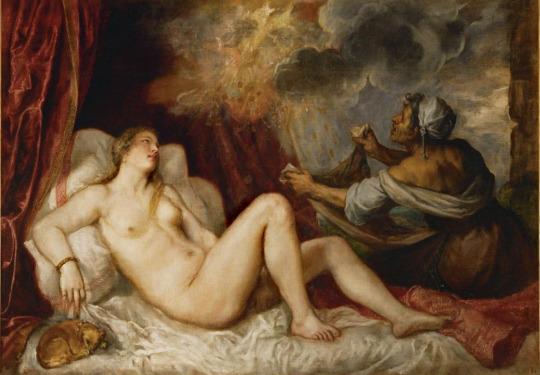
Figure 4. Titian’s Danaë
The contrast between premeditated design (Zheng) and the untrammeled naturalness (Yi & Qi) can be seen in the Western art, too. In Titian’s famous work Danaë (figure 4), the body of the woman to the left is derived from Michelangelo's female figure in the sculpture at the Medici Chapel entitled Night, possessing a great designing effect and sculpturality (similar to Jiang and Liu’s Zheng style); on the contrary, the white satin under her body is sketched by the bold slash of the brush (similar to Wang, Lu, and Liu Sha Zhui Jian’s Yi & Qi style), suggesting an unbridled idiosyncrasy, thereby foretelling the arrival of Baroque art.

(From left to right):
Figure 5 (a): Fu Shan’s imitation of Wang Xizhi’s Letter Written in the First Lunar Month
Figure 5 (b): Liu Sha Zhui Jian

(From left to right):
Figure 6 (a): from Figure 5 (a)
Figure 6 (b): from Figure 5 (b)
Figure 6 (c): from Figure 5 (a)
Figure 6 (d): from Figure 5 (b)
Figure 6 (e): from Figure 5 (a)
Figure 6 (f): from Figure 5 (b)
Fu Shan (1607-1684), who was the master for Qi’s style, considered premeditated Zheng’s design as a bete noire and he preferred untrammeled naturalness in his art. In Figure 5 (a), though it is Fu’s imitation of Wang Xizhi’s work, it bares greater resemblance to the wooden slip Liu Sha Zhui Jian in Figure 5 (b). Fu and Liu Sha Zhui Jian employed an unmodulated linearity (Figure 6 (a) and (b)), an untrammeled leisure (the “丿” in Figure 6 (c) and (d)), and an unembellished naturalness (the last horizontal line in Figure 6 (e) and (f)). Both of them epitomized Qi & Yi concepts.
It is worthwhile mentioning that Fu never had the chance to see Liu Sha Zhui Jian, which was excavated in 1906-1907 (see my previous Zheng Xiaoxu’s post), around three hundred years after Fu’s time. The striking similarity between Fu’s work and Liu Sha Zhui Jian testifies Fu’s inimitable capacity to imagine the broken part of the art history by tracing the path of calligraphic evolution.
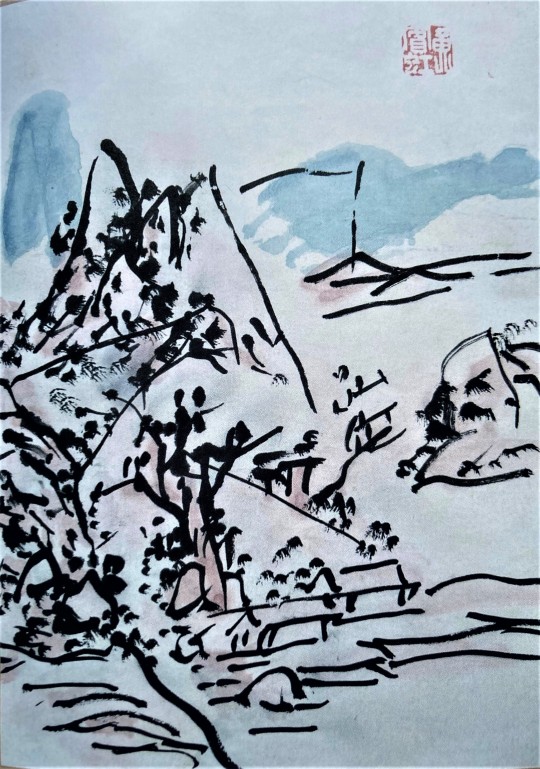
Figure 7: Huang Binhong’s Landscape Painting
Fu’s Qi legacy is carried on by Huang Binhong (1865-1955), an extraordinary Chinese modern landscape painter whose brushwork is characterized by raw, unmodulated, and untrammeled naturalness. The brushwork of Huang’s painting in Figure 7 bears a strong correlation to Fu’s brush in Figure 5 (a) and the satin of Danaë in Figure (4)---they are ad-libbed in the spur of the moment, implying an ephemeral yet highly-spiritualized transcendentalism.
According to The Petty Sayings of Painting, a famous thesis on Chinese painting esthetics, Chinese landscape painting is similar to the writing of cursive and running script --- the creation should not be restrained by rigor and workmanship (i.e., premeditated design, or Zheng). Dong Yuan’s (c. 934-962) interplay of voids and solids (see Figure 8, Dong’s The Rivers of Xiao and Xiang), Mi Fu’s (1051-1107) smoky mountains improvised by horizontal dots, Mi’s son Mi Youren’s (1074-1153, or 1086-1165) The Ink Play of Cloudy Mountains (see Figure 9), and Huang Gongwang’s (1269-1354) withered trees and lean mountains (see Figure 10, Huang’s Nine Submits after the Snow) exhibit a feeling of untrammeled naturalness. On the contrary, “only the vulgar artisans will deliberately create the meticulous paintings in order to please the audiences’ eyes.” The paintings made by this pleasing servitude is “drab and dour.”

Figure 8. Dong Yuan’sThe Rivers of Xiao and Xiang

Figure 9. Mi Youren’s The Ink Play of Cloudy Mountains

Figure 10. Huang Gongwang’s Nine Submits after the Snow
Yi & Qi also happens under Cezanne’s (1839-1906) hands. In Montagne Sainte-Victoire (Figure 11), Cezanne did not choose a refined brush to design remote mountains; instead, he created a simple calligraphic line as his abstract rendition of the landscape. For all these artists, mastering a skill of unpremeditated and sophisticated disegno (Zheng) is not difficult (and indeed, they did so when they were young); what challenged them most was how to get rid of formulaic design and create a free, simple, and impromptu Yi & Qi effect. By doing this, they presented their own characters rather than representing the rules and regulations of traditional and formulaic style.

Figure 11. Cezanne’s Montagne Sainte-Victoire
View more posts from the Zhou Cezong Collection of Chinese scroll and fan work.
– Jingwei Zeng, Special Collections graduate researcher.
#graduate research#Jingwei#Chinese calligraphy#Chinese fans#Chinese art#Chinese paintings#Chinese history#art history#calligraphy#calligraphers#Zheng style#Qi style#Jiang Qingji#Sun Guoting#Liu Gongquan#Wang Xizhi#Lu Ji#Liu Sha Zhui Jian#Fu Shan#Titian#Michelangelo#Huang Binhong#Dong Yuan#Mi Fu#Mi Youren#Huang Gongwang#Paul Cezanne#Zhou Cezong Collection#Tse-Tsung Chow Collection
36 notes
·
View notes
Quote
When future generations look back to my time, it will probably be similar to how I now think of the past.
Wang Xizhi
後之視今,亦由今之視昔。
Hòu zhī shì jīn, yì yóu jīn zhī shì xí.
8 notes
·
View notes